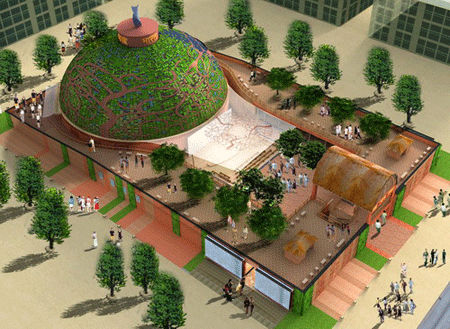
A visit to the world’s largest bamboo-made dome at the Shanghai Expo paves way for mutual understanding between China and India, says India Pavilion director D.K. Nangia.
Visitors are amazed at a central dome with a diameter of 34.4 meters. It is a recurrent theme in Hindu, Buddhist, Islamic, Jain, Sikh and Christian architectures throughout India.
More than 60,000 plants sit on its roof, which collects rainwater for use in the pavilion.
The interior of the dome reflects the theme of “Living in Harmony Through the Ages” with displays on India’s city planning, thought and philosophy, education and knowledge, science and technology, democratic governance and statecraft, arts and cultures.
An eye-catching holographic audio visual showcases the Seven Chakras (circles of energy) and how the ancient system inspires urban development.
“This unique feature of the India Pavilion represents the country’s long tradition of living in harmony with nature,” Nangia said.
Hanging on the wall of his office is a portrait of Mohandas Karamchand Gandhi, renowned for his Satyagraha Movement of non-violent opposition to British rule and for questioning the Western modernization path in the early 20th Century.
“Environmental degradation has reached a horrific level. The stress of living in high-cost urban areas leads to impatience and that needs to be controlled. So, our stress in the pavilion is harmony, which is a trademark of India,” he said, sipping a cup of Indian red tea.
For this purpose, bamboo is used in the construction of the dome for its low cost and inherent strength, he explained.
Nangia believes Indian-style harmony is the harmony of civilizations, harmony with nature and an eco-friendly development path, with Hinduism playing a central role in the diversified communities in India.
“In India, Hinduism has traditionally been a soft way of life. It teaches us religious tolerance. It is difficult to grow fast without harmony.”
Nangia said the dominant teaching can be applied to the development of modern cities. “Cities generate wealth, cities generate employment opportunities. So they have to be looked after well.
“A good city is one which offers opportunities for all types of people. At the same time, it is not too taxing on the environment,” he said.
Urbanization is developing fast in India. By 2020, more than 60 percent of Indians will live in cities. A major task, according to Nangia, is to care of the rural poor in parallel with urban areas.
He cited the National Rural Employment Guarantee Act (NREGA) as a successful example. Under the scheme implemented in 2005, everyone in the rural areas is guaranteed for 100 days each year, like building small dams and cleaning ponds.
“If all these things become effective, the pressure on cities would be lessened, as they would be less inclined to move into urban cities. They can think of modernizing small villages and small townships,” Nangia said.
He said the Expo was a good platform to link the “India Tiger” and “China Dragon,” especially at grassroots levels.
“I appreciate the progress we are witnessing in China, and I have seen that people in China react very fast. The way Shanghai authorities have moved to create a green area around the Expo is something we should be proud of.”
He did not support the notion that China and India are competitors. “They are the powerhouses of world economies in the foreseeable future. Everyone has its own role to play,” he said.
The Indian pavilion has proved to be one of the hottest spots during the Shanghai Expo, boasting on average 25,000 visitors everyday. They swarm into the shops to buy Indian handicrafts, or taste the curry, accompanied by the Bollywood dances and songs.
“People want to sit down and talk with us. This is what I call people-to-people contact, which is a very good factor in bilateral trade. China and India are both original cultures. None is perfect perhaps, so one has to learn and benefit from each other.
“I believe once we have a person-to-person contact among the policy-makers, students and others, commerce and business will flow naturally.
The Expo provides information of capabilities of each other, which is naturally spread through personal contacts.
“There are millions and millions of websites in the Internet age of trade, but there is nothing to beat the person-to-person contact.”
Authors : Gong Yidong, Xu Xiaoqing
Source : http://news.xinhuanet.com




